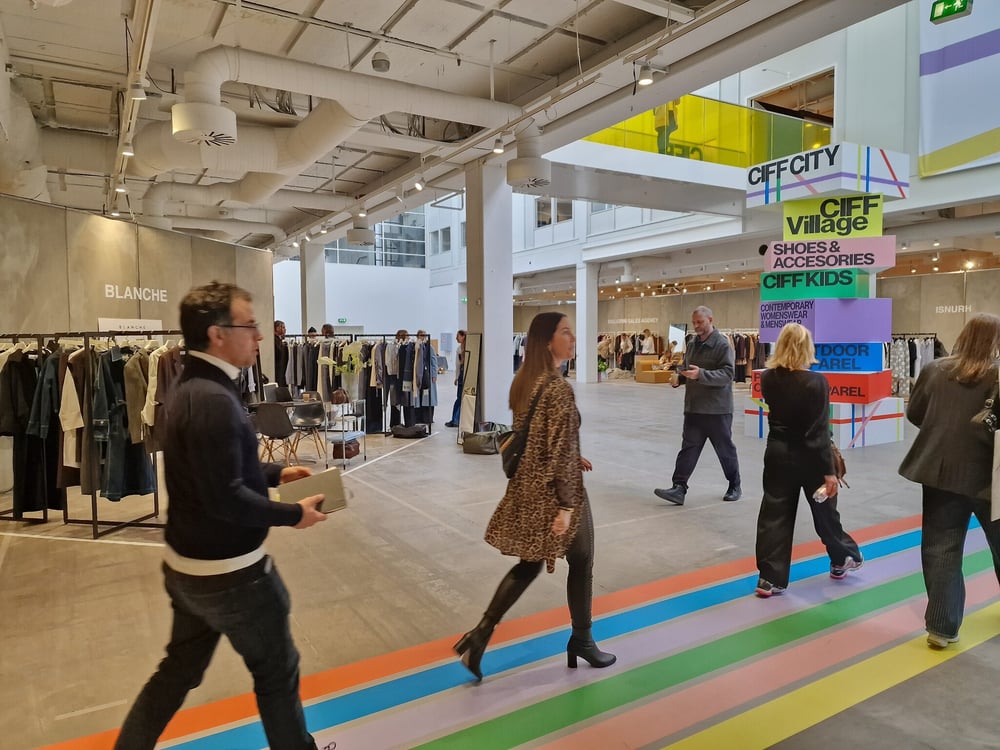CIFF Establishes Itself as a Premier Fashion Trades Destination in Northern Europe

The stars seem to be aligning for the CIFF show in Copenhagen. The professional fashion event in the Danish capital concluded its winter session on February 2, after three days of great activity, so much so that it presented itself as a new stronghold of Northern Europe.
“We had 400 brands a year ago and 1,000 in this session,” explains Sofie Dolva, general director of the show, which last year recorded the acquisition of the historic local competitor Revolver, bringing together all the exhibitors at the Bella Center, the exhibition space in the eastern area of the Danish capital, located about twenty minutes by metro from the city centre. “We have learned a lot in recent months from this development. We also took advantage of the feedback from the previous edition by working on the readability of the universes, emphasizing the scenography and creating spaces in which exhibitors and visitors could stop, exchange ideas and rest”. In fact, the universes are well defined. At the fair's entrance, a large space attracts creative brands and innovative start-ups, separated by tall gray walls with a rough concrete print. A pavilion is dedicated to the mid-range offering, another space brings together outdoor fashion brands, while the world of footwear and that of children have their own, well-identified areas. In the large hall, where contemporary, denim and more classic ready-to-wear brands are located, displays of lifestyle and beauty products have been placed in the heart of the aisles, easily identifiable by the large white veil placed above their stands.
By bringing the two Copenhagen fairs together in the same place, the organizers have made the event more attractive. Even before the end of the show, a strong growth in visitors had been recorded: between 20,000 and 22,000 people went to CIFF. But more importantly, the event attracted people from far beyond Scandinavia. CIFF and Copenhagen Fashion Week have benefited from the decline in Berlin shows in recent seasons. While the German capital saw its business events disappear one after another, operators in the German and Central European markets had to look for new commercial platforms.
“It's really positive for us, we have many German brands that have joined us this season, including locomotives like DryKorn,” explained the manager, satisfied to record these dynamics with the arrival of Essentiel Antwerp, but also the return of local players such as the women's ready-to-wear brand Masai or the Custommade brand, which revealed a more premium positioning. All this, despite a still tense economic context.
“We saw that more than 60% of visitors who pre-registered were from abroad. And 17% of the visitors were from Germany, but we also see people coming from Asia and Canada. And the large exhibitors, such as DK Company (which has around ten brands, ed.) see more international presences". And even if buyers are cautious this season, according to the majority of exhibitors consulted, the activity in the aisles of the fairgrounds was very dynamic.
“The merger with Revolver seems very positive to me,” confirmed Per Biltoft, agent for Scandinavia for the Dedicated brand, “with just one show, we no longer wonder if the buyers are elsewhere”. As for visitors, buyers from a Parisian department store admitted to having extended their visit to the show after visiting the pavilions and discovering the offer. Copenhagen therefore seems to have performed well in this season's international trade fair competition. Beyond an hourglass game with Berlin, several other elements can explain the attractiveness of the Danish capital. Naturally, the fair's organizer has invested heavily to gain momentum, taking greater care of the scenography, but also inviting international buyers and press to discover its developments.
The company also benefits from an original concept, which combines an exhibition space with permanent lounges, the CIFF Village, where Scandinavian agents and retailers are used to going and which includes local brands and showrooms of international labels. With an exhibition space almost 90% occupied, this activity also brings economic solidity to CIFF, according to the general management of the event.
The other strong argument: Copenhagen is based on an image as a stronghold of responsible fashion. In 2023, CIFF has partnered with the American CFDA to bring a dozen labels with ecological DNA across the Atlantic, and plans to forge new partnerships with other international players this year. The aspect of eco-responsibility is clearly a strong point, and many brands spoke about it at the fair. “My approach is based on the use of responsible and natural materials,
The aspect of eco-responsibility is clearly a strong point, and many brands spoke about it at the fair. “My approach is based on the use of responsible and natural materials, whether they are GOTS certified or use unused stock. I chose to exhibit here rather than in London because there is an understanding of these topics.
And I didn't regret it,” explains Camille Jaillant, founder of the high-end French brand Olistic, for which this was the first participation. Same story from premium streetwear brand ISNURH where Kasper Juhl Todbjerg, the co-founder, appreciates visitors' interest in responsible materials, especially its garments made from Rodinia, a biodegradable material. Far from the frenzy of Milan and Paris, this Danish week has managed, according to all, to attract, and, apparently, to seduce, many new visitors, residing far beyond the borders of Scandinavia.
“In Paris or Milan, visitors are always in a rush. Here they take the time to wander around, to look for new labels,” says Emma Migliorini Kristensen, general director of the Migliorini showroom, which presented the offer of half a dozen brands, mainly French. “There were many visitors from Germany and Benelux who were looking for something new.”




